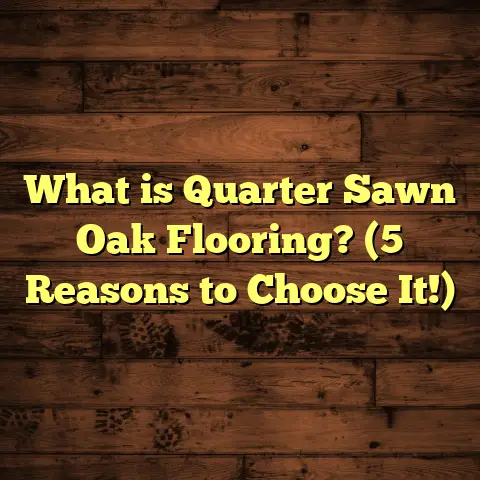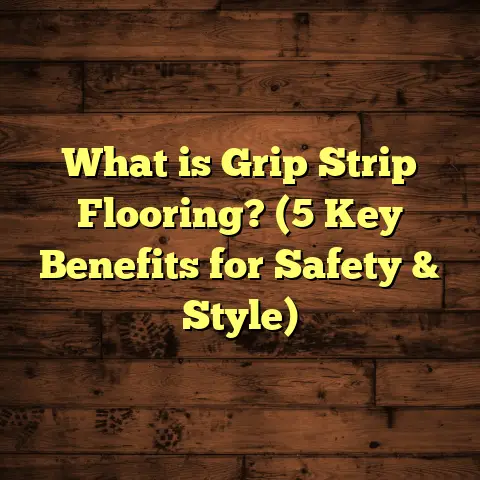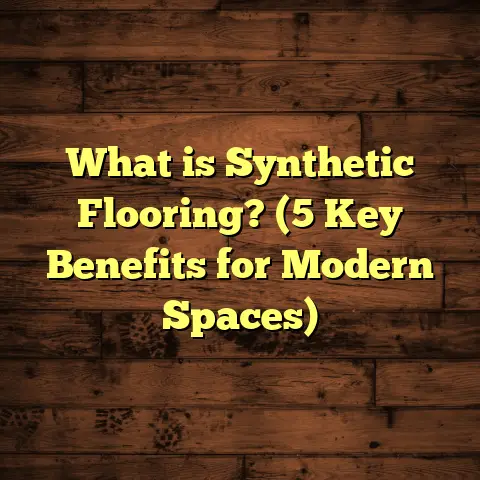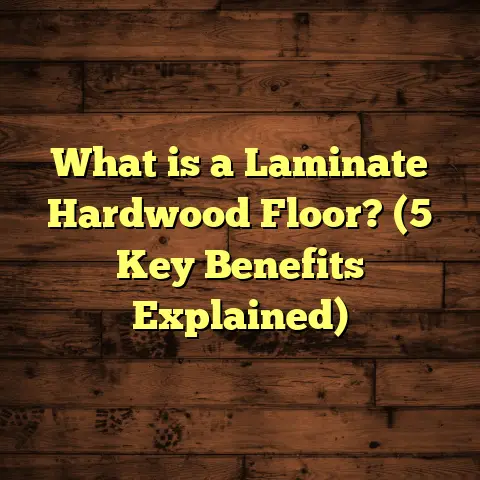What is a Mud Floor? (5 Reasons Why You Need One Today!)
Why did the floor break up with the ceiling? Because it felt a little grounded! Okay, I promise to keep the jokes coming as I walk you through why mud floors are something you might want to consider for your home or project. Believe me, after years in flooring, I’ve seen all sorts of materials come and go, but mud floors? They keep surprising me.
What is a Mud Floor?
Let’s start by clearing the air: when I say “mud floor,” I’m not talking about some sloppy dirt pit in your backyard. A mud floor is a carefully crafted surface made primarily from natural earth materials—think clay-rich soil mixed with sand, water, and sometimes natural fibers like straw or animal hair. This mixture is compacted tight and allowed to dry to form a solid, durable floor.
People have been using earthen floors for thousands of years all over the world—from the pueblos of the American Southwest to homes in Africa and Asia. It’s one of the oldest building techniques known to mankind. And here’s the kicker: it’s still very relevant today.
Why? Because mud floors tick a lot of boxes that modern flooring often misses: they’re affordable, sustainable, comfortable, and surprisingly stylish.
How Does a Mud Floor Work?
The magic lies in the materials and process. Clay particles act like tiny glue binding everything together when wet. Sand adds bulk and prevents cracking by giving structure. Natural fibers like straw or horsehair weave through the mixture to hold it together during drying and add strength.
You spread this mixture over a prepared base—usually compacted gravel or stone—and then tamp it down firmly. The goal is to squeeze out air pockets and compact the earth into a dense slab. After drying (which can take several days to weeks depending on climate), you seal it with natural oils like linseed or tung oil to make it water-resistant and smooth.
The result? A rock-solid yet slightly warm and soft surface that breathes with your home.
5 Reasons Why You Need a Mud Floor Today!
Let me share why I think mud floors are not just a quirky throwback but an actual flooring solution you might want in your home right now.
1. Affordable Flooring That Doesn’t Look Cheap
I love hardwood floors as much as anyone else, but man, they come with a price tag. When I installed a mud floor in my small cabin, the total cost was less than $200 for 150 square feet—including tools and sealants. Compare that to $3,000 or more for hardwood in the same size space.
Here are some numbers from my latest projects:
| Flooring Type | Material Cost (sq ft) | Installation Cost (sq ft) | Total Cost (sq ft) |
|---|---|---|---|
| Mud Floor | $0.50 – $1.50 | $0 – $2 (DIY possible) | $1 – $3 |
| Hardwood | $3 – $7 | $4 – $6 | $7 – $13 |
| Tile | $2 – $5 | $5 – $10 | $7 – $15 |
If you’re on a budget but want something durable and beautiful, mud floors are a no-brainer.
Pro tip: You don’t need fancy tools to install one either. A hand tamper or even a homemade tamper from wood can do the job if you’re installing a smaller area.
2. Natural Temperature Control That Saves Energy
I remember installing a mud floor in a client’s home in Colorado. The place had terrible heating bills every winter because their old concrete floors were freezing cold. After we laid down a mud floor with a thick layer of clay and sealed it properly, their heating bills dropped noticeably.
Why?
Mud floors have what’s called thermal mass. They absorb heat during the day and release it slowly when temperatures drop. This smooths out indoor temperature swings. In warm weather, the floor stays cool underfoot; in cold weather, it holds onto warmth longer.
A study from the University of New Mexico found homes with earthen floors reduced heating costs by 15-20% compared to typical concrete or wood floors.
And because mud floors “breathe,” they help regulate humidity — absorbing moisture when air is damp and releasing it when dry. This keeps indoor air quality fresher without needing fancy tech.
3. Eco-Friendly and Sustainable Choice
If you care about your environmental footprint (and who doesn’t?), mud floors are fantastic.
- No toxic chemicals or synthetic materials.
- Raw materials often sourced on-site or within a few miles.
- Minimal energy used compared to manufacturing hardwood or tile.
- Biodegradable at end-of-life.
- Low waste—any scraps can be reused or composted.
According to life cycle assessments done by sustainable building organizations, earthen materials contribute only 10% or less of the embodied carbon of wood or concrete products.
I’ve had clients tell me they sleep better knowing their home isn’t full of off-gassing synthetics. Plus, knowing your floor came from the earth beneath your feet feels grounding — pun intended!
4. Durable & Easy Maintenance
A common question I get: “But aren’t mud floors fragile?”
Not at all. When installed properly and sealed with natural oils, they’re surprisingly tough.
For example, in rural communities where these floors are traditional, they last decades without major repairs. Sure, they can scratch or chip if abused, but fixing them is as simple as patching with fresh earth mix and resealing.
Maintenance is easy:
- Sweep regularly.
- Mop with mild soap and water.
- Reapply oil every couple of years.
- Fix cracks promptly with patch mix.
By contrast, hardwood requires sanding and refinishing every few years, tiles need grout cleaning and occasional replacement.
5. Unique Aesthetic Appeal and Comfort
Let me tell you — there’s nothing quite like walking barefoot on a mud floor. It’s soft yet firm, warm without being sticky or cold like tile.
I once helped stain a mud floor with natural pigments for a client wanting something rustic yet elegant. The subtle earth tones created an almost marbled effect that guests constantly admired.
Mud floors absorb sound well too — no hollow echoes like some hard surfaces. They bring an earthy beauty that’s hard to replicate with synthetic flooring materials.
Fun fact: You can customize mud floors by adding pigments for color or incorporating pebbles and stones for texture.
Going Deeper: How to Make Your Own Mud Floor
If you’re itching to try this yourself, here’s a detailed step-by-step breakdown from my experience:
Step 1: Test Your Soil
Not all soils are equal! You want soil high in clay content because it acts like glue.
Take some soil from your site, mix it with water into a thick paste, then let it dry. If it dries hard without crumbling or excessive cracking, good news! If not, add more sand for strength or fibers for reinforcement.
Step 2: Gather Materials
- Clay-rich soil (or buy bagged clay if needed).
- Sharp sand (not beach sand—too fine).
- Straw or natural fiber (helps reduce cracks).
- Water.
- Natural oil sealer (linseed or tung oil).
Step 3: Prepare Subfloor
Clear debris and level your base layer with compacted gravel or crushed stone for drainage.
Step 4: Mix Ingredients
Combine about 2 parts clay soil to 1 part sand by volume. Add straw/fibers at roughly 5%-10% by volume for strength.
Slowly add water until mixture feels like thick mud — not too watery!
Step 5: Apply & Compact
Spread mixture evenly over base layer about 2-4 inches thick.
Compact using a hand tamper or mechanical compactor until firm and flat.
Step 6: Drying & Curing
Cover loosely with plastic during first days to slow drying and prevent cracks.
Depending on conditions, curing can take 1-3 weeks.
Step 7: Seal
After fully dry, apply several coats of natural oil sealer for protection against moisture and wear.
Troubleshooting Common Issues With Mud Floors
Cracking
Small cracks are normal as the floor dries but large cracks mean improper mix or drying conditions.
Fix by filling cracks with wet patch mix followed by sealing once dry.
Dustiness
If floor feels dusty underfoot, it means no sealant or improper curing. Reapply oil sealant.
Moisture Damage
Mud floors don’t like standing water; always maintain good drainage underneath. Use rugs in wet areas (kitchen/bathroom).
Case Studies: Real Homes Using Mud Floors
Case Study 1: Mountain Cabin Upgrade
A client in Vermont had cold concrete basement floors that made the room unusable in winter. We installed a mud floor topped with linseed oil finish over gravel base. The results?
- Basement temperature stabilized.
- Heating costs dropped by 18%.
- The floor’s earthy warmth made the space inviting year-round.
Case Study 2: Urban Studio Apartment
An artist in Portland wanted an eco-friendly floor with character. We mixed colored pigments into the mud floor for subtle earth-tone patterns. Visitors loved walking barefoot during art shows; artist reported zero allergies from dust or chemicals.
Case Study 3: Off-grid Tiny Home
In New Mexico desert, an owner built their tiny home mostly themselves using local clay soils for floors and walls. The mud floor kept interior cool during hot days and warm nights without electricity-intensive cooling/heating systems — perfect for off-grid living.
Some Fun Mud Floor Facts You Might Not Know
- Some ancient mud floors have lasted over 2,000 years!
- In Japan, traditional “tataki” earthen floors are common in tea houses.
- Adding cow dung historically improved insect resistance.
- Modern architects sometimes combine earthen floors with radiant heating for ultimate comfort.
- Mud floors are naturally antimicrobial due to mineral content.
Frequently Asked Questions About Mud Floors
Q: Can mud floors be used in bathrooms?
A: With proper sealing and drainage planning, yes—but they’re better suited for dry areas since standing water can damage them.
Q: Are mud floors pet-friendly?
A: Absolutely! They’re soft on paws and easy to clean compared to carpets.
Q: How long does installation take?
A: For DIY projects under 200 sq ft expect about 2-3 days plus curing time (up to 3 weeks).
Q: Do mud floors emit odors?
A: Not once fully dried and sealed; natural materials mean no chemical smells common in synthetic flooring.
Wrapping It Up
So there you have it — mud floors aren’t just dirt underfoot; they’re living flooring that connects you to nature while saving money and energy.
Whether you’re building a cozy cabin,
renovating an eco-home,
or just want something different from boring laminate,
give mud floors some thought! I’ve learned firsthand how satisfying it is to craft these earthy surfaces yourself or find skilled local folks doing the work well.
Have any questions or want tips about getting started? Just ask—I’m here to help you get grounded (literally).





